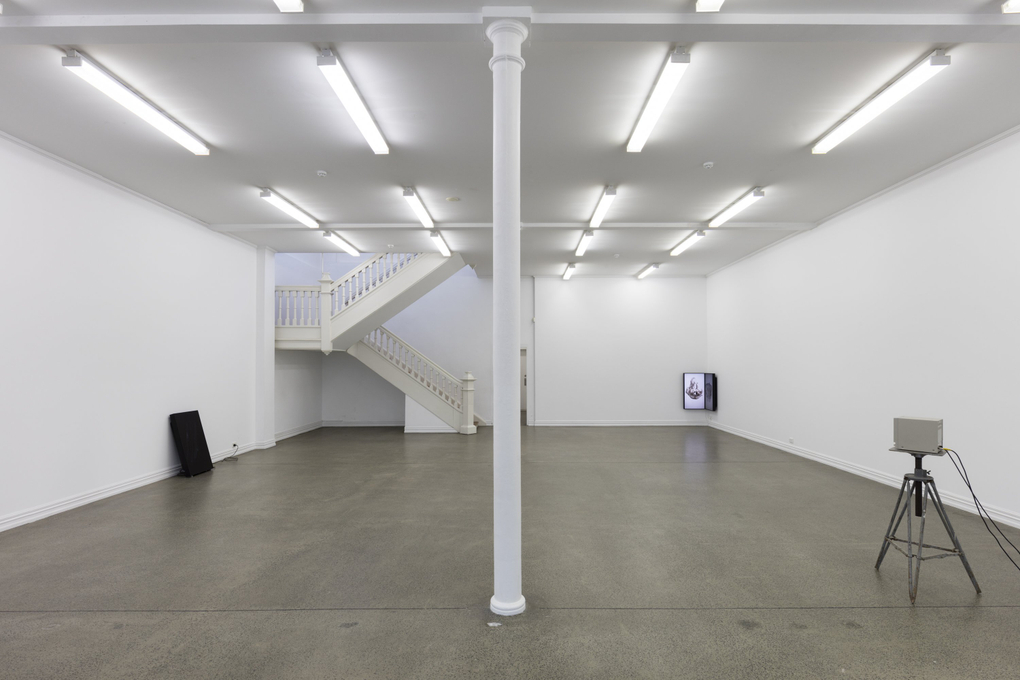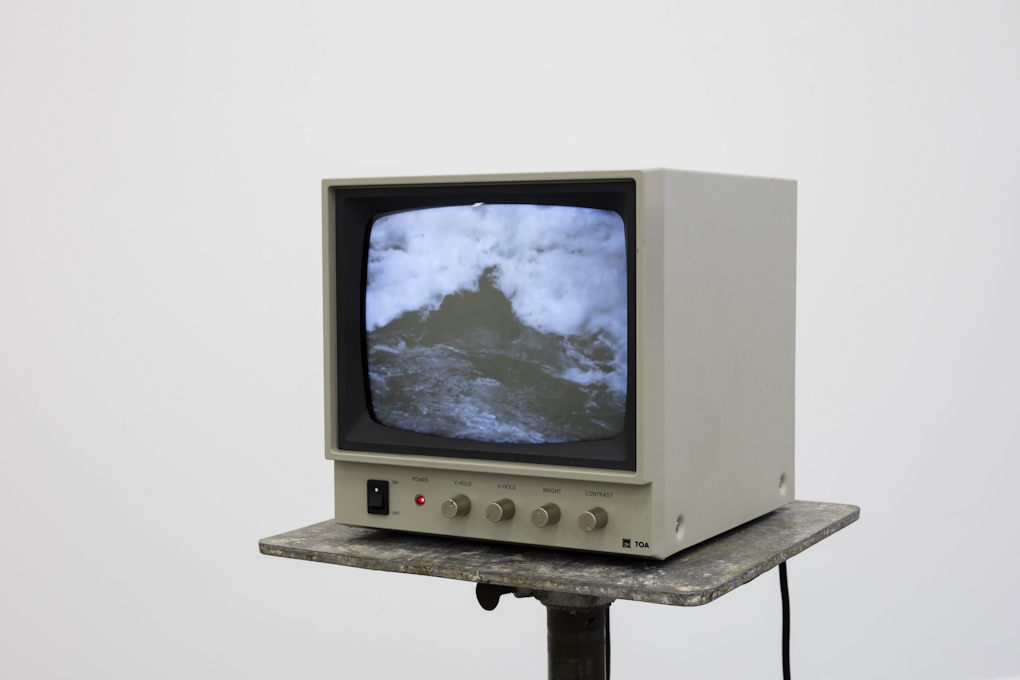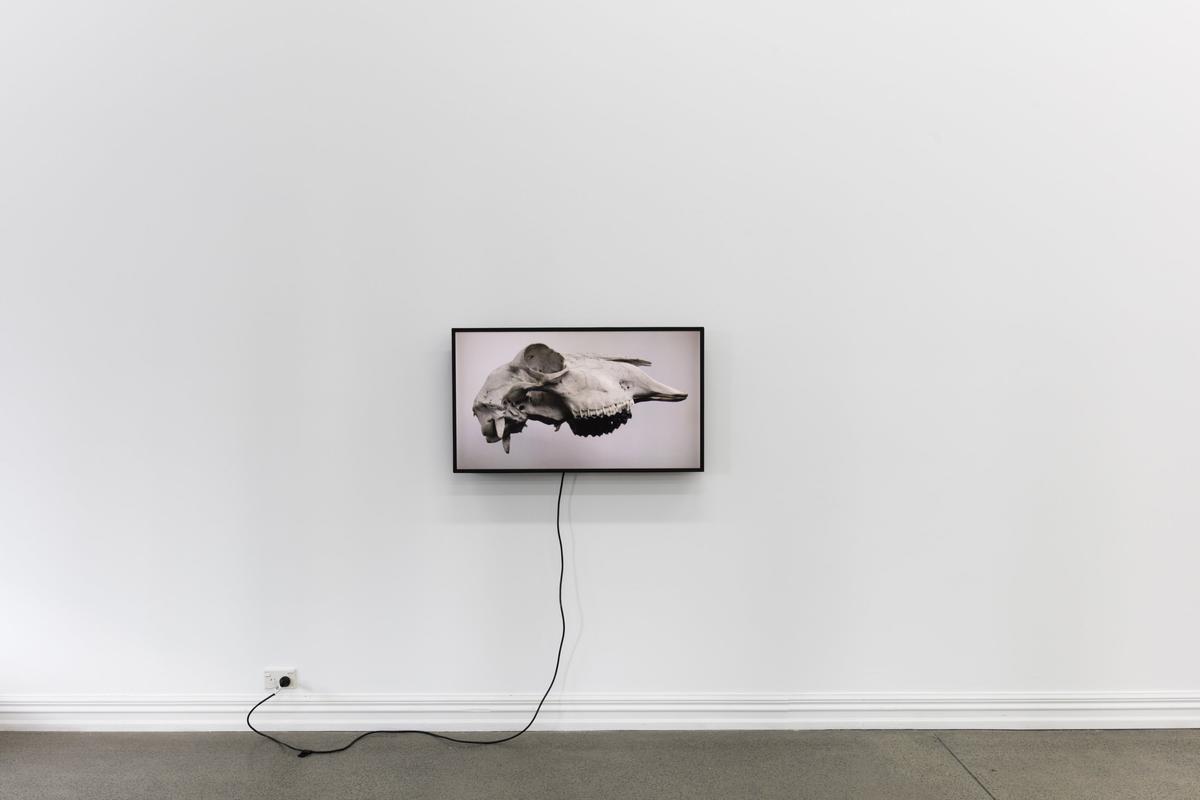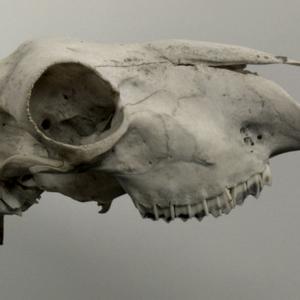Mark Williams (MW): Most of the works we're discussing today I first saw in the exhibition lowercase, which was at Starkwhite in 2016. Walking into that show, I was reminded me of the final scene of 2001: A Space Odyssey (1968), where the astronaut enters the room, and comes face-to-face with himself, as if he has entered some sort of psychic museum from the far future.
Clinton Watkins (CW): Excellent.

Installation view of lowercase (2016), Starkwhite Gallery. Photo by Sam Hartnett.
MW: But the dominant motif for me was the video of a spinning chunk of black obsidian. This is a substance formed from cooled volcanic rock, it has all sorts of meanings in different cultures: psychic protection, truth telling, feng shui. What does it mean to you?
CW: What does it mean to me? Wow. First of all it was a family connection. The piece of obsidian was in a cabinet, at my grandparents'. And I was obsessed with it, at a very young age. How it was made, the volcanic processes and [so on]. It remained in the cabinet for 30 years, maybe longer. Recently my grandfather passed away, and I saw it again, visiting my grandmother. She said, “Oh you can have that.” And I was like, “Are you serious? That thing that I've been kind of obsessing over privately, in the recesses of my mind all these years?”
I remembered my grandfather saying that he had found it on some beach in the far north. I can’t recall where. But that's the legend. I don't need to know all the details. It's just an image that's in my mind, of my grandfather in his younger years, finding this black thing. And then it's been bequeathed to me.
CW: But in terms of my more mature years, [my interest lies in] the force behind it, [the] volcanic procedure making black glass in an instant of a second. And I started thinking about black being an absorber of all colour, as opposed to white, which reflects it. Some people say black’s not a colour but it’s all colours.
And then there was this sort of ominousness, which I really like. It actually represents this recurring nightmare that I've had all my life, which is this large, black rock that's floating, sphere-like, irregular in form. And I encounter it, and it's the opposite when I touch it. It's soft, and I can kind of push into it. So it's the complete opposite of what it ought to be.
MW: That's a hell of a recurring nightmare.
CW: That's a hell of a one. There's many others as well, but this connects to that. So it's deeply personal, in terms of the obsidian itself. And then it comes to black on black, [which] I've always enjoyed. That's what made the work really hard for other viewers to see, apparently. And I was like, “That's great.” I didn't make it to be easy.
Clinton Watkins, dark matter (2016). Digital Video, Silent.
MW: And next to the mineral element, you had this animal element of the two skulls.
CW: Bleached by white light of the sun.
MW: Yeah.
CW: It has this binary aspect to it. Yes/No. Black/White. And [these are] deeply personal objects that I have either found myself, or has been found by a family member. So there's this whakapapa element coming through, which is something that has been a recent revelation.
MW: Who found the two skulls?
CW: I found those. I need to find the object. I don’t go Trade Me and buy it. There's a process of a journey to find something like the skulls. You know, you don't find them in urban areas, you need to go and hike within the country. Perhaps that's something to do with my own roots, in terms of families running farms way back.
Clinton Watkins, stereo (2016). Digital Video, Silent.
MW: In all three videos, the objects shown were presented as weightless. Why was that necessary?
CW: I guess it's about suspension in time, and questioning time itself. We understand time in a linear way, and naturally, we're always one step further from birth as opposed to the other way round. In the video it’s continuously feeding back on itself through spinning. So it's timeless, almost. The spinning thing is a fairly recent revelation. (Initially) I was getting someone to throw the skulls and filming them.
MW: Very 2001. The bone in the sky.
CW: That's where it came from. But, you'd only get maybe half a second-worth of footage. I needed something a bit more sustained. So I devised a very simple technique to make those float in space. The object is suspended within the frame via nylon, which you can't really see unless I point it out. And I spun the object quite rigorously, for quite some time, so the nylon starts to wind up on itself. I'd leave it for about an hour, and leave the studio with the object just spinning wildly. And then I'd return in about an hour's time, and I found that by leaving it like that, it'd balance itself.
MW: Returning to the weightless quality of the objects; they're embedded within technologies that also seem weightless, but in fact they carry an awful lot of impact. LCD screens are made from extracted minerals, and in turn, the screen needs an electricity supply to power it up.
CW: Okay, let's talk about power. In the literal sense the works are powered by the AC mains. Water is essentially powering everything through hydro dams. That's why that work eternal wave (2016) was in the exhibition. Water adheres everything together. Without that it’s nothing. It's really, really important to kind of acknowledge water in terms of where we are (in New Zealand) in terms of power.
And in turn, these screens which have a lot of dangerous elementary chemicals in them such as mercury. So it’s a comment on technology and its destructive capabilities. Technology is seen initially as the beacon of hope whereas it could be a beacon of the opposite.

Installation view of eternal wave (2011), Starkwhite Gallery. Photo by Sam Hartnett
MW: Let’s go back a little bit to the start of your career. At art school the printmaking department seems to be where your practice really came together. What drew you to that department, that discipline?
CW: I'd come from painting, found it really viscous, sticky, and literally I got sick from touching the medium too much. I was doing noise music, experimental music. (I wondered) how can I incorporate this into my practice? I started thinking about print and realised that records are an etching, and therefore can be printed off multiple times—stamping—etching—printing. So that validated me making records in the printmaking department. I did screenprint onto [the surface of the actual] records. [For example] you had an Opera and a screenprint of Virgin Mary on it and then you played them—two very pure things—and they'd fuck each other up. And then I thought I could make my own records. And of course King Records came about. [So I was able to press lathes.] And that opened the door to [using them in] installation.
MW: And that was also when you began working with video?
CW: I began using video alongside my sound installation/recording work within the print making dept. At the time I didn't like video cameras so I put them onto turntables and spun them whist filming, a form of torture perhaps, and coming up with almost Tony Conrad Flicker-type works which I then put panning sound works to by using two VHS decks. I then stopped working with video in 1999 due to not having access to video equipment that I couldn't afford and continued purely working with sound on my 4-track until I began my Masters degree at Elam in the then Intermedia department. I had access to a DV camera through the department and thats where the Continuous Ship works arose from—by testing out a camera to see if I liked video again. The rest follows from there...
MW: Talking more about sound, I'm interested in your use of volume. Ahead of this conversation you sent me a bunch of French Raw Black Metal from the 1990s, most of which was blasted to tape. But your recent work is very pared back, controlled, quiet.
CW: Volume is like fidelity. I remember Chris Knox saying fidelity is just a way of describing the timbre as opposed to its quality or resolution, which I quite liked.
MW: Can you explain that a little more?
CW: Fidelity doesn't have to be crystal clear like 4K. Why does it need to be low or high? It's just fidelity. I like that concept as opposed to a hierarchy of high-low.
Raw Black Metal has been really useful in terms of reinforcing the attitude or sensibility for making work. It's a very specific genre of metal that has been a guilty pleasure of mine for over 20 years but it's only recently surfaced through my work. I guess it provides a sense of strength that I distill within my own projects in a certain way. Southern Lord records have a saying which is "maximum volume yields maximum results" and I've kind of adapted that saying "limited means equal maximum results."
But then there's the actual amplitude, loudness or the lack of. Of course I’d been working with high volume stuff for many years. I guess [the shift] is something to do with having children, having neighbours, not having a rehearsal room and all these sorts of things. I think it reveals that it's okay to be quiet. You can be quite affective with low volume. With lowercase, every video piece had the same soundtrack. It was a monotonous droning sound. I used the speakers of the monitors to relay the sound, knowing the gallery space was highly reverberant, so that would naturally amplify the sound. Eventually it filled the space quite successfully without hitting high amplitude. You became aware of it over a short space of time.
I'm also thinking about gallerists. Being courteous. Can you imagine being in a gallery with high amplitude sound for a month? Recently I was asked by Santiago Sierra to redo a sound piece we’d done a few years back. It was a high amplitude, incredibly low and high frequency work that was made to make you feel really bad. It was really successful in that sense, and he wanted to do it again, but they vetoed it, because the gallerists would have to put up with it for six weeks and they just couldn't deal with that. I was like, fair enough, so we canned it. You can get away with a lot more if it's low volume. You can still have the same sentiment, it just doesn't have to be high amplitude.
axis (2018) Clinton Watkins. Digital Video, Sound
MW: Collaboration has been a big part of your practice recently. What was the catalyst for working with Jim Speers in China?
CW: Well, first it was a gig. I was employed to do the sound recording for Jim Speers for this project he was working on about people working on the barges on the Yangtze and what it was like for them to be living on the water. But then Jim was like “Let's expand this and turn it into a collective,” and we started to work with Li Xiaofei, a Chinese artist who was based in Shanghai at the time. Then we got another member to purely deal with camera operation, and we had another member come on with the translation, which was really important.
That immersion [in China, via the project] was really important to infiltrate this other world that we're not really exposed to as Westerners. What that revealed was the reality outside of the Prada stores and all that glitz and glamor that we see as tourists.
In Shanghai there's three rings, the inner, mid and outer ring. Like Detroit, the further you go out the more impoverished or industrial it gets. We were going beyond the third ring near the airport and that's on the coastlines. So we were meeting with people who were really on ground zero in terms of providing the raw materials for the infrastructure—concrete, steel, wood, fuel, all these sorts of things.
We figured out that this was something that had occurred across a very short space of time. That whole industrial zone—of Shanghai especially—only really started happening in the early 1990’s, which is kind of frightening in terms of the duration we're thinking about here, considering it’s 2019, and the catastrophic level of industrialisation that occurred within that short space of time. That project revealed the decimation of land and the environment for industrialisation for the sake of it. It was quite harrowing actually.
Clinton Watkins, locations (2017)
MW: Were many of the locals particularly concerned or conscious of the environmental impact?
CW: It didn't seem to be too much of concern. They'd finish a bottle of whatever and just lob it into the water. I still don't really understand where that's coming from, maybe it’s about critical mass or something like that, I don't know. The outskirts were really revealing and then the interior, the inner circle, you have absolutely no idea.
MW: Have you any interest in returning that project to China?
CW: We exhibited the work at the Rockbund Museum of Art which is a pretty major contemporary art gallery in Shanghai. I think it was quite revealing for inner circle types to see what it was actually like to be on these barges which they basically just kind of calipered off. They don't even notice them, they're just part of the furniture.
It was still hard to tell what the actual response was. Our glue to that was Li Xiao Fei, the Chinese artist that we worked with. Its kind of an extension of his practice, he's been doing this series called Assembly Line Projects for quite some time, where he goes to multiple factories within China and interviews workers in terms of the conditions that they are working in and the impact that may have on them physically, psychologically, socially. But rather than being a singular entity it was a collaborative work. That was a big challenge for him because he has a very specific way of making.
MW: What's your next project?
CW: Filming through plastic bags.
MW: Oh yeah?
CW: It's a defiance of resolution. We've got 4K, 5… 6K, now 8K resolution and there's this need for absolute perfection in the image. By mediating the camera through plastic creates a visual effect, but it's actually the plastic. I'm not using that in an ecological kind of sense, it's more about the distortion. I think absolute clarity is a ruse and we need to have a bit of murk or fuzziness for reality.
MW: So what are you going to point the camera at?
CW: I'm thinking storms at the moment. When a storm occurs I go out filming. Basically it's just a high contrast image that's blurry. It's a play between light and moving forms. So whatever the subject matter is, whether it be storms or something else almost becomes irrelevant, as it comes back to that formal notion of filming through plastic.
With the sound based work, long form compositions which are married to video imagery. I like the analogy of a deck of cards, I have all this material in a vault and then I shuffle the deck and then I see what combinations happen. It's about improvising with combinations.
MW: I think this a great lesson for young artists, always to have a few irons in the fire and in future something might resonate and that might equal that.
CW: And there's the whole question of it being experimental. You expect an error. When I see stuff like that out there, it really gets me going because it's not perfect, it's raw, maybe littered with mistakes. A level of bravery is useful.

